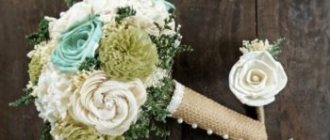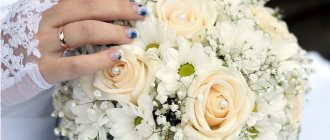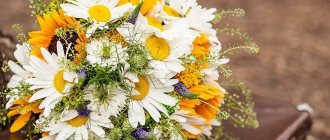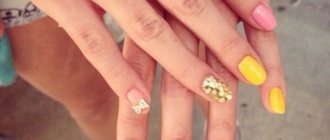The wreath of Dionysus was traditionally woven from ivy and grapes.
The round shape of the wreath and the living component symbolize eternity, constancy, endless life, and connection with the divine nature. Perhaps this is why the wreath in many cultures became a symbol of royal power (the crown came from it).
In Slavic lands, the wreath also acquired the meaning of love.
Floral wreath on the head: how to secure at the end?
Securing the wreath at the end is of great importance, not only because it will be important for you to give it a neat and aesthetic appearance, but also so that the finished product cannot come undone unexpectedly at an important moment.
Any thread or ribbon will be useful for securing. If you don't have any on hand, you can pick any dense grass and twist the "joint" of the wreath several times. Try to do the tying carefully and so that it is not noticeable to the eye.
Weaving and fastening a wreath
Tying the end of the wreath with a ribbon (artificial flower wreath)
For autumn walks
Walking through the autumn forest, we admire the beauty of the golden carpet of leaves on the ground and so want to come into contact with it, to take at least a little with us. We suggest you collect maple leaves and make a wreath on your head. It is more convenient to work with slightly damp leaves. The photo below shows the manufacturing process of the product. And such a headdress made of autumn leaves will decorate your head.
Related article: New Year's snowman made from boxes
Decor, for example, from rowan branches, will add more color to such a wreath.
Compositions made from leaves will decorate not only your image, but also your home. In the options shown below, you can use a base made of newspapers (described in the master class below), on which we then place all the material from the forest.
How to make a wedding wreath of fresh flowers for your head?
The wedding wreath has become a trend and its relevance has continued for the last few years. This wreath adds charm and sophistication to the girl, it looks great with a simple loose-fitting wedding dress, and adds style to wedding photographs.
You should not choose a wreath to match a fluffy dress, since this accessory itself is already spectacular, and additional pretentiousness will only spoil the impression. A modern wedding wreath can be made of artificial or fresh flowers. In any case, you should independently choose flowers in delicate bed or white shades that can be combined with clothes and makeup.
IMPORTANT: Your hairstyle will also become much more impressive with a wreath. For a wreath, flowing straight hair, hair with a slight wave or gathered in a bun are suitable.
Wedding images in wreaths:
Images of brides wearing wreaths of artificial flowers
Large flowers made from foamiran in addition to live ones on wedding wreaths
Weaving a wedding wreath from gypsophila
Large flowers on wedding wreaths
Fresh bright flowers in a wedding wreath and in a wedding bouquet
Large roses in a wedding wreath
Wreath of fresh flowers and wheat ears
Wedding wreath made of pearl beads and gypsophila
Paper wreaths
The wreath can be made from corrugated paper.
We will need: corrugated paper, scissors, glue, wire.
We cut the wire into short pieces and wrap it with strips of green paper. Periodically coat with glue for reliability.
We cut squares from white paper, fold them into an accordion and round one edge. Then we wind the yellow corrugated paper onto the wire (this will be the core of the flower) and wrap the white piece around it.
Now take a strip of pink paper and cut the fringe from one edge. We twist the strip around the wire piece. Next, we fold an accordion out of orange paper and cut out the petals, as shown in the photo below. Unfold the strip and twist it around the pink center.
Next, cut out narrow leaves from green paper. Then we place all the blanks on the base of the wreath. We use glue and strips of corrugated paper.
You can use foamiran to create a wreath and make something like this from orchids.
Related article: Macrame for beginners with patterns: master class with photos and videos
In general, the flowers themselves for the wreath, whether to decorate your home or your head, can be made from absolutely any material, for example, burlap.
And from wire and beads you get simply airy products.
This is how, in our time, seemingly forgotten wreaths still remain relevant and acquire a variety of forms and creation techniques.
LiveInternetLiveInternet
WREATH - HISTORY AND TRADITIONS
A wreath is a traditional decoration among the Slavs, but few people know where the tradition of weaving wreaths came from and what such an unusual headdress symbolizes. The word “Wreath” itself comes from the Old Slavonic veno “gift”. Wreathmaker - a woman who weaves and sells wreaths. A wreath is a ring woven from herbs, branches, flowers, which is worn on the head as a decoration. The wreath is a traditional decoration not only for Slavic, but also for many other peoples, and has a very ancient history. Wreaths existed in ancient Greece, where they were awarded to winners of various competitions, heroes, warriors, rulers, in Rome, China, and India. Wreaths were hung above doors and at entrances to ward off evil spirits or destroy the evil thoughts of an evil person or a person with a “bad eye.” Wreaths were placed under the first sheaf of the new harvest to prevent rodents. They placed it under the pillow of a woman in labor to ward off the evil eye and help in future childbirth. They also fumigated the sick with a set fire to a wreath made from special herbs. The herbs that were woven into the wreath were used to judge the girl’s disposition, mood, condition, and position. For example, a wreath of mint in Poland meant virginity, and a wreath of pea shoots with full pods meant a girl’s reluctance to marry someone she didn’t love. In Rome, a wreath made of laurel leaves was considered a sign of military glory and imperial power, and a wreath made of oak leaves was awarded to warriors who showed particular courage in battle or saved their comrade. The Romans considered myrtle wreaths to relieve intoxication, so feasts were often held in such wreaths. But a wreath made of thorns was intended for those sentenced to death. The Arabs intended a wreath of orange flowers for the bride as a symbol of fertility. The Chinese awarded the olive wreath to writers, poets, and writers. Making a wreath Making a wreath is a whole ritual. In various tribes, as well as on various holidays, the weaving of wreaths was accompanied by numerous traditional elements. Girls usually did this. The ritual implied a certain time of weaving, the number of wreaths, sizes, shapes, different types of weaving and composition. All this was a sacred-symbolic code that corresponded to a particular event. Particular attention was paid to the composition of the wreaths. If today wreaths are woven for fun or as a tribute to ancient tradition from any herbs that come to hand, then in ancient times each type of wreath consisted of certain plants, for example, on Rusal week and on the holiday of Kupala, wormwood was woven into the wreath as a remedy against evil spirits. strength. In addition, wreaths, which consist of certain herbs and are placed on the head, are real aromatherapy, which can give a beneficial state, set one in the right mood and even help cure some diseases. Initially, a wreath was a ritual object that was woven for holidays - seasonal, sacred, weddings, funerals and others. A wreath is a real amulet. Since ancient times, objects and things that have a hole have been considered charged with a special power, capable of scaring away entities or negativity that are disgusting to a person. This is connected with the feminine principle, a symbol of feminine nature and magic, a symbol of the birth of life. Similar traditional magical objects were rings, hoops, rolls, stones with a natural hole (Chicken God). Due to the fact that wreaths were also amulets, they were used to decorate pets and various parts of their home, both outside and inside. Wreaths were decorated not only with people and livestock, but also with houses and buildings, wells, pillars, cemeteries, and thrown onto fruit trees in vegetable gardens and the roofs of houses. In some regions, special wreaths were woven for cows, goats, sheep, and in the villages of Pomerania, the custom of weaving wreaths for geese, turkeys, chickens and other poultry was even preserved. As for the festive and ritual purpose of the wreath, there are many different traditions associated with the use of this simple object. Livestock was milked through the Kupala wreath or milk was filtered. They climbed through the large wreath themselves, as if symbolizing a new birth, which left illness, negativity and troubles in the past. Also, various things were pulled through the wreath to which they wanted to give new life or new strength. People looked through the wreath during certain ritual games; they drank and washed through it. There are more than enough purposes for the Kupala wreath, and each region of ancient Rus', tribe or settlement had its own characteristics and methods of using it. At the end of a holiday or event, wreaths were used either for further protective actions, for example, decorating a house, placing them in gardens to protect against pests, worms and hail, placing them under a hen, using them for fortune telling, or burning them in a fire. There were many fortune tellings using wreaths. For example, fortune-telling is known for the Slavic summer solstice holiday Kupala, when woven wreaths are thrown into the river and the future fate of its owner is determined by their behavior. This fortune-telling has many interpretations: a sinking wreath means death, a floating wreath means long life, or a sinking wreath means a year without marriage; by a wreath floating or stuck to the shore, they determined in which direction the betrothed’s house was located. In addition to fortune telling with the help of wreaths thrown into the river, wreaths were thrown onto a tree to find out who was promised a quick marriage (whose wreath would catch on a branch), they were left in the yard and watched whose wreath would wither faster (misfortune threatens), they were placed under the pillow to see prophetic dreams and so on. Wedding wreath Due to the fact that a wreath (a circle with a hole) is considered a symbol of birth and new life, it was an indispensable attribute of weddings. Along with the wreath, traditional wedding attributes also included rings, rolls, and loaves with a hole in the middle. All these are symbols of new life, love, happiness. The custom of the Slavs also included the tradition of giving a wreath to a girl as a sign of a matchmaking proposal. The bride's wreath symbolizes rebirth as a wife. Renewal of a person, shedding the old life and entering a new life. This is, in a way, a symbol of the dying of the old, girlish life, the renewal of soul and body and the birth of a new life as a married woman. Marriage wreaths, unlike holiday ones, were usually preserved for a long time or even for life. Wedding wreaths were kept in chests, they were placed in a red kut, where they, safely drying, stood for many years, were sewn into a pillow for the newlyweds, and placed under the cradle of a newborn. It is possible that it was the ancient tradition of decorating with wreaths at weddings, the exchange of wreaths between the bride and groom, that served as the prototype of the rings, which then began to be made in forges especially for weddings, and today in jewelry workshops. There was a custom to weave a wreath at the last harvest. At the end of the harvest, the last sheaf was left, which is also known as “Veles for the beard.” This sheaf was left in the field or brought into the house, where it was stored until the next year, as a talisman that would attract a good harvest the following year. In addition to the last sheaf, a wreath was also woven from the last mown ears. Such a wreath was placed on the head of the most beautiful girl, who was a symbol of good luck, good fertility, a symbol of the goddess of fertility, who gave people a good harvest. Wearing this wreath, the girl came to the settlement where the holiday was being held and where she, of course, was the main character of the celebration, who was praised and thanked for the bountiful harvest. Wreaths have long been an indispensable attribute of funeral ceremonies. Wreaths are laid on graves or left at the place of death, or floated on water in the event of a shipwreck. In modern funeral ceremonies, wreaths are a tribute to the memory of the deceased. A wreath as a ritual object at a funeral symbolizes the same birth and eternal life. A circle with a hole in the middle symbolizes the transition of the souls of the deceased to another world and his birth in a new body, in a new quality, renewal of the soul, purification that the death of the physical body brought to the soul. A wreath can also be understood as the end of a life’s journey, the beginning of a new path, whether in the physical world or in the world of Navi. Due to the fact that wreaths were an indispensable attribute of weddings, there is an assumption that in ancient times wreaths took part in funeral rites only at the funerals of children, teenagers or young people who did not manage to get married. Thus, a symbolic wedding was arranged. Along with the funeral and wedding wreath, there was also a custom of burying unmarried girls in a traditional wedding dress (outfit), which is still known today. There is also an assumption that wreaths are the oldest concepts about bird souls who make nests (wreaths) near their graves and wait for their new incarnation, but this is just a theory. Subsequently, wreaths made of leaves, branches and flowers began to be replaced with artificial materials that could last longer. It is believed that after wreaths began to be made of metal, royal crowns appeared, which became a distinctive element of the ruler’s clothing...
Vasilisa Velesova▾
12 Oct at 16:31











